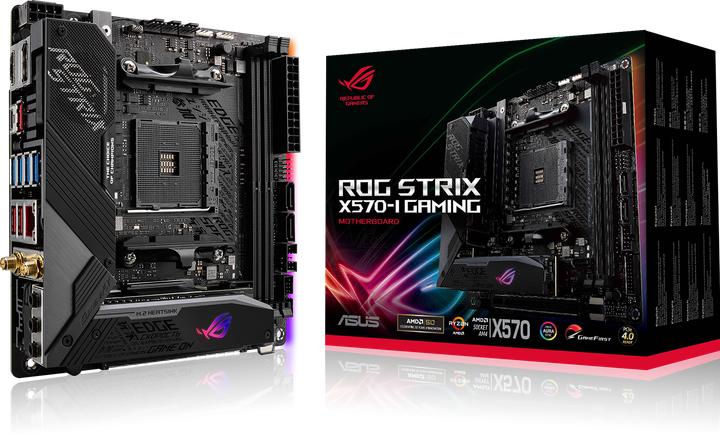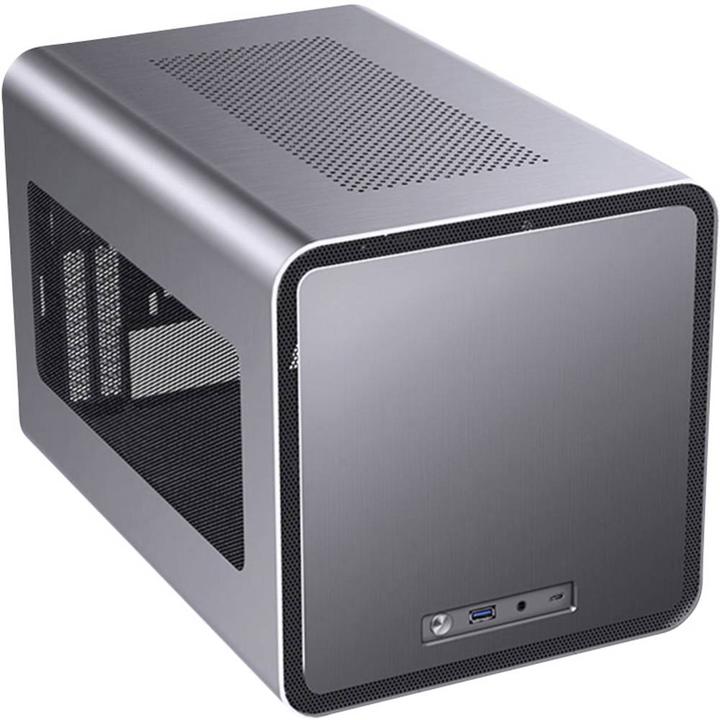
Jonsbo V8: The high-airflow housing with a deficit
The Jonsbo V8 attracts my attention with its extendable housing cage. The manufacturer promises easy building with mini-ITX or mini-DTX mainboards with less potential for frustration. The supplied 200 millimetre fan and openings on five sides should ensure plenty of airflow.
The Jonsbo V8 looks a little chunky. Not at all like a mini-ITX case, but more like a small midi case. The block looks a bit like a letterbox with mesh. I kind of like that.
The tests
I'll get straight to the results without further ado. I explain the features, assembly and build quality in the video or you can read more below.
Because an AIO water cooling system can easily be installed in the Jonsbo V8, I'm doing two tests. One with the Noctua NH-L9a and one with the Corsair H100i.
To test the airflow, I subject the components installed in the case to the HeavyLoad (for the CPU) and FurMark (for the GPU) stress tests.
I run the stress tests for 20 minutes. I use HWiNFO64 to measure the temperature of the CPU, GPU, SSD, motherboard and chipset. Unfortunately, I can't provide any information on the VRM as the sensor is apparently missing here. At least HWiNFO doesn't give me any values. I do the test in my home office. The room temperature is 20.5° Celsius before the test with the Noctua cooler and 22.2° Celsius after twenty minutes. I leave the fan control set to standard in the BIOS. I note the temperatures after every five minutes. In this configuration, I measure 40 dB at idle and 46.5 dB under load with the sound level meter from a distance of 30 centimetres in front of the case.

The V8 gets quite warm when tested. The thermal imaging camera shows temperatures above 60° Celsius. The CPU runs at its thermal limit of 95° Celsius after 20 minutes of testing. I also had the same result in the review of the Kolink from Rocket. As the V8 is relatively large, the temperatures of the other components are lower than on the small Rocket. The mainboard and chipset remain four to five degrees cooler. There are no differences with the SSD. I can't compare the graphics card as I have a 2070 installed in the Kolink. The 2080 Super from KFA2, which I could easily install despite its 2.5 slot thickness, remains ten degrees cooler in the V8 than the 2070 in the Rocket. However, this is not only due to the case, but also to the cooling performance of the installed 2080: The heat sink is larger and can therefore cool more efficiently.
The high temperatures surprise me, as the aluminium casing has mesh panels on both sides. It also has large openings at the back and top to allow warm air to escape. I was sceptical about the supplied 200-millimetre fan in advance, wondering whether it would actually provide fresh air. Although it has a mesh frame at the front, a large part of the front is covered by the aluminium plate - directly in front of the fan. I hardly felt any airflow from the 200-millimetre fan during the test. I can only speculate whether the better temperatures in the V8 compared to the Rocket are due to the fan or the additional space and ventilation openings.

The AIO provides much better temperatures. Nevertheless, I'm surprised at how hot the CPU gets. 81° Celsius is a lot for the Ryzen 5 3600XT. In the review on the open testbench, the CPU got 75° Celsius and that was with a Noctua air cooler. I would have expected similar temperatures in the case with the AIO. Since I installed the AIO as an exhaust fan, it ensures better airflow in the case. The temperatures of the mainboard, chipset and SSD therefore drop by three to five degrees. However, the whole thing comes at a price: although the system ran at a relatively quiet 39 dB at idle, I measured 56 dB under load. That is very loud and annoying.
I also don't know exactly what the 200-millimetre fan at the front achieves. However, I suspect that it is the AIO that draws in fresh air from the sides and therefore ensures better airflow and thus lower temperatures for the chipset, mainboard and SSD.

The letterbox with that certain something
In contrast to other mini-ITX cases, the V8 also accommodates mini-DTX mainboards. With this standard, a PCIe slot is available in addition to the PCIe slot. With a capacity of 25 litres, it is one of the larger mini-ITX cases.

The extendable housing cage is a special feature of the V8. I only have to loosen two finger screws and then pull the cage out of the aluminium casing. Once I have the innards out, there is plenty of space.
- Space for four fans; 200 millimetre fan supplied at the front
- Space for a 120, 140 or 240 millimetre radiator
- SFX or SFX-L power supply unit
- Drives: up to two 3.5 and one 2.5 inch
- Maximum CPU cooler height: 19.5 centimetres
- Maximum length and thickness of graphics card: 33 centimetres and 2 slots
- Ports: one USB 3.0 Type-A, one USB 3.0 Type-B and one 3.5 mm audio

You will look in vain for an air filter. At first glance, the housing is designed for airflow due to the many openings.

The casing looks well made, although the edges are relatively sharp. On closer inspection, I can also see that the holes at the top are not all punched out evenly.
The assembly
In the video above, you can see what I like and dislike about the housing. So here are my experiences with the assembly in a reduced form:
Simple
Thanks to the extendable housing cage, all components are relatively easy to reach.
Inconvenient
Mounting the power supply because the bracket is also screwed on under the front fan. I have to remove the fan first. The cables should also be attached to the power supply unit before mounting, otherwise it will be tight.
A pain
The lack of cable management options causes frustration during assembly. The cables are lying around in the housing and can't really be attached.
Conclusion of the assembly
Despite the extendable case cage, the building experience is similar to that of most other Mini-ITX cases: What I can do outside, I do outside - especially the front panel connectors.

Conclusion: I would have expected more
At the beginning of the test, I was full of hope: the V8 looks quite good and promises good airflow thanks to the mesh panels and 200-millimetre fan. In reality, however, things look different. The fan is probably suffocated due to its position behind the closed front panel and is unable to push enough fresh air into the interior of the case. Without airflow, the mesh panels on the side are of no use either. The Rocket from Kolink, which is less than half the size, doesn't deliver much worse values with the Noctua air cooler.
With the AIO water cooling system, things look a little different. Thanks to this, a draught actually forms in the case, which ensures lower temperatures for the components. Nevertheless, I would have expected more.
Because of the deficient airflow, the inadequate building experience and the workmanship that is not beyond reproach, I cannot recommend the case. A pity, really. With a few optimisations, such as a full mesh front panel and a few options for cable fastening, the V8 could be a really great case. However, it doesn't seem to have been thought through to the end.
From big data to big brother, Cyborgs to Sci-Fi. All aspects of technology and society fascinate me.









